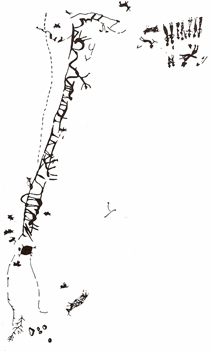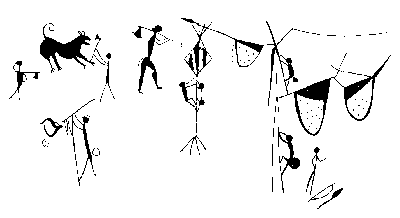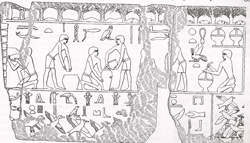The honey bee first appeared on our planet in the Tertiary period at the beginning of the Cenozoic era, that is 65 million years ago - much earlier that the appearance of humans. If we assume that honey appeared together with bees, we can conclude that until almost the 16th century after Christ, honey was the only naturally sweet food in the "known" world.
MythologyIn Greek mythology, the bee and thus honey, directly or indirectly, occupy an important place.
- Goddess or Demon? Half bee half winged-woman, the shape of the Great Mother Goddess, of Pre-Artemis, i.e. with a close relationship to the gods of vegetation.

Depicted on tablets and medallions of gold or amber from Rhodes, Milos and Santorini. - Artemis of Efessos. Depictions of bees together with animals and roses on the goddess's garments. Goddess of fertility and virginity. The priestesses of Artemis of Efessos, Rhea, Cybele, Demeter and Persephone were also called "Μέλισσαι" or Bees.
- Zeus (Melisseus "honeyed" or Melisseos-Isihios "honeyed-kindly"). According the the myth, Bee Priestesses fed and raised Zeus in the Ideon Andron Cave in Crete.
- Apollo. Apollo ate nectar and ambrosia and became so handsome that his father, Zeus, called him the god of light.
- Bee Priestesses. Honey is connected with myths concerning prophetizing priestesses, such as Pythia and the Thria Priestesses.
- Aphrodite-Eros-Honey. Theocritus tells us in his famous poem that Eros wanted to steal honey combs full of honey, and as punishment the bees stung him, thereby making symbolic reference to the bitter-sweet nature of love.
- Trophonius. God-like child who was fed honey by nymphs in a cave, the road to which was indicated by bees, or the so-called trophoniades. Trophonius was a pre-Hellenic agragrian deity (god of rain and vegetation) with therapeutic and prophetic abilities. His parents were Bacchus and Persephone, Apollo and Epicaste, Zeus and Jocaste, and Erginus and Jocaste.
- Aristeus. Another pre-Hellenic agrarian deity of vegetation. Son of Apollo and the nymph Cyrene who was kidnapped by the god on the banks of Pineus River and was led to the distant Lybia. Aristeus was born there and Hermes brought the newborn to the Hours and to the Earth in order to make him immortal by feeding him nectar and ambrosia. Adored as the the protector of herds, oil and honey. According to Nonnus (Dionyssiac 5, 212-286), the bee hive, flaxen attire and using smoke against bees are attributed to Aristeus. The same author refers to Aristeus' offering of honey to the gods and to humans and of wine to Dionyssus.
- Hebe and Ganymede. The Olympian gods were fed ambrosia (honey) and nectar, served by the goddess of youth, Hebe (daughter of Zeus and Hera) and later by Ganymede, after Hebe's marriage to Hercules.
- Glaucus and Polyidos. Glaucus, the son of Minos and Pasiphae (or Crete), drowned in a jar of honey and was brought back to life by the diviner Polyidos with the help of a magical herb. The myth was very popular in antiquity, and the expression "Γλαύκος πιών μέλι ανέστη", or "Glaucus drank honey and was resurrected", was commonly used for someone who was at risk of death but survived. Aeschylus, Sophocles and Euripedes all used the myth in their works, Polyidos (Diviner), Polyidos and the Cretans, respectively.
- The Underworld (Hades). Hermes is disguised as a scarab in order to call the spirits of the underworld while a bee flies overhead. The dead, in their journey to the underworld on the Acheron River, need to carry a honey pie in order to placate Cerberus, the guardian of Hades.
- Roseyfingered Eos. The Goddess Aphordite "cursed" her not to find erotic satisfaction when Eos enchanted Ares. In the "hunt" for a partner, she met Tithonus, kidnapped him and fed him ambrosia to keep him forever young and strong.
In this historical period, humans were hunters and food was strongly linked to the area inhabited. In rocky areas, bees easily found shelter for their hives. In the same areas, humans illustrated the process of this impressive hunt. Honey hunters, not animal hunters. In other words, food hunters who do not kill the animal that produces the food - a sweet food which was unique until the discovery of sugar.
- Mesolithic cave drawings (6000 BC) in Spain depicting people collecting honey with bees flying overhead are the earliest depictions of honey gathering.

Mesolithic cave drawing from Arana, Spain
In: Eva Crane. The World History of Beekeeping and Honey Hunting
Mesolithic cave drawing from Balencia, Spain
In: Eva Crane. The World History of Beekeeping and Honey Hunting
- Late Mesolithic drawings of bees have also been found in caves in India. The bees are clearly identified as Apis Drosata (large-bodied Asian bees) from the size and shape of the combs.

Late Mesolithic cave drawing including Apis Drosata from Rajat Prapat in Central India.
In: Eva Crane. The World History of Beekeeping and Honey Hunting
Vessel for bee smoking. Sesklo (4500-3300 BC). National Archeological Museum of Athens. (The vessel could also have been used for straining the honey after pressing the comb.) - The oldest discoveries in Greece, dating from the late neolithic period (4500 - 3300 BC) were made in Sesklo, Thessaly and show depictions of a goddess and a vessel, most likely for smoking the bees.
- Similar drawings have also been found in Africa (KwaZulu Natal, Zimbabwe), Asia (Bhutan) and Australia (Queensland).
The data from this period are so abundant that they could surely fill dozens of books. Here, we will limit our discussion to the Mediterranean region, although it should be noted that there is historical evidence for beekeeping and honey use from all areas of the world, as would be expected the prehistoric findings mentioned above. It is clear that during the ancient period honey was not only used a food but also played a prominent role in religious rites and in the preparation of medicinal remedies, creams, aromas, beverages (alcoholic and digestive) and was slowly being traded from country to country.
- The first records (2700 BC) of the pharmaceutical and nutritional value of honey were found in Mesopotamia, the birthplace of the first organized communities.
- The earliest known evidence for systematic bee-keeping in "clusters" of multi-cylinder clay hives comes from Ancient Egypt.
According to the myth, bees and wax were born from the tears of the Sun-god Ra, and the bee was considered as a guide on the long journey to the other world of the afterlife. Reliefs from as early as the 5th Dynasty (2480-2350 BC) depict the harvesting, filtering and storing of honey. It is certain that honey was used as an antiseptic and possibly in the mummification process. It seems that its use was originally a royal privilege and its use and commerce spread to the general population only after the Middle Dynasty (2060-1786 BC). Anaylsis of the contents of a hive found in a 19th Dynasty grave (1350 BC) in Thebes (Deir el-Medineh) revealed pollen grains, which aided in the estimation of the degree of change in the honey-producing plants over time. During this period, the Egyptians placed hives on ships travelling Nile, in search of flowering plants. In other words, we have the first attempt at nomadic bee-keeping. The hunt for "wild" honey was very popular and was protected by the King's army. Beekeepers were among the King's subjects with privileges, but honey was taxed. There were renters and subletters of the royal hives who payed rent either in currency or in honey. Greeks took part in this segment of the economy, usually as renters.
Relief from the Temple of the Sun (Ne-user-re, Abu Ghorab). Egypt 2400 BC.
From: Eva Crane. The World History of Beekeeping and Honey Hunting
- In Ancient Greece, the bee, honey and beeswax held a very prominent position in social stratification. From the Linear A and B tablets of Knossos, Mycenea and Pylos we have obtained valuable information regarding honey transport, even though systematic beekeeping is not mentioned.
Both Homer and Hesiod cite the wild bee in caves and oak trees. During the Classical and Hellenistic periods, there is a greater quantity of information which indicates a more systematic occupation with beekeeping, mainly in agricultural areas. More than 41 different types of containers for honey transport and storage are named, emphasizing that honey commerce entered a thriving and profitable phase. The same conclusion can be reached indirectly by examining the numerous coins found with a variety of bee depictions. The oldest of these comes from the city of Meliti in Thessaly and dates from the beginning of the 4th Century BC. Coins with bee images were also found on Crete, Kea, in Efessos and in Sicily. There were more than 50 names for honey and honey products, indicating their wide use. According to one of Solomon's laws, beekeepers were obliged to place their hives 300 feet (100 m) apart so as to avoid any doubt regarding the ownership of the swarm. Archeological digs have uncovered rich material in the form of horizontal and vertical hives, mainly made from clay. During the 3rd Century BC, honey prices ranged between 16 and 37 silver drachmas per "measure", or 9 oboli and 3 ½ drachmas per "choun" ("measure" and "choun" are measuring containers for honey).
Ornament found at Malia, Crete (2000-1700 BC).
Honey varieties are cited in many texts, with separate reference to "unsmoked" honey, or honey from hives which were not exposed to smoke during the honey harvesting. Based on the season of production, honey was categorized as "vernal", "fair" and "autumnal". Honey from locations such as Mt.Hymettus, Megara Hyblaea in ancient Sicily, Salamina, Leros and Kalymnos was renowned.
Black-figure amphora depicting a honey theft scene. Basel, Switzerland. Antiquities Museum (540-520 BC).
Source: Aggeliki Liveri, 6th Proceedings of the PTI ETBA 2000 three-day workshop.
In "Cyrus' Anabasis," Xenophon describes the poisoning of solidiers with rhododendron honey from the Black Sea. The remains of General Agesipolis were transferred to Sparta from Aphytos in a jar filled with honey, in the same manner that the remains of Alexander the Great were moved.
Most of the "scientific" information regarding bees and their biology comes from Aristotle's "History of Animals" and "Generation of Animals". Theophrastus, Aristotle's student, continued this work. Aristotle describes bee activies in detail, and his works served as the basis for related research after the Middle Ages. Amongst the "errors" of observation he made, the two described below are rather important:
- Aristotle believed that the bees collected wax from plants. With the means at the time, it was impossible to describe the "birth" of wax from the wax-producing glands. This process was described much later after the invention of the microscope.
- Aristotle described the queen as the "sovereign" of the hive, attributing the male gender. This is indeed surprising for such a significant researcher. The texts of several other writers (Xenophon, Arrian, Pappus of Alexandria) refer to the queen with her proper gender, indicating this fact as common knowledge. There have been many references to this subject, and the most likely explanation of Aristotle's error is that his observation was the result of common opinion regarding the roles of males in females in society at that time.
The historical references to honey and honeybees are very numerous. In addition to the writers mentioned above, historical figures such as Homer, Hippocratus, Democritus and Pythagoras also wrote on the subject.
The image of the bee is signifantly represented in jewelry, gold tablets, sculpture and in pottery.
Honey was consumed daily, as is as well in cooked foods and other preparations. We have the following information regarding its use:
- Milomel. Apples preserved in honey for storage. This honey acquired an apple aroma. Other fruits were used as well.
- Melikrato. Honey and milk. A beverage for children.
- Oxymel. Honey and vinegar. Used for the treatment of fever.
- Hydromel. Liqueur made from the alcoholic fermentation of honey. Still produced today.
- Oenomel. Honey and wine. There are references indicating that Democritus lived to a very old age because he consumed oenomel and bread
- Aristotle believed that the bees collected wax from plants. With the means at the time, it was impossible to describe the "birth" of wax from the wax-producing glands. This process was described much later after the invention of the microscope.
- In the Roman Period, honey production and use not only continued, but also increased significantly for three reasons: First, the use of honey in food and in therapeutic preparations was generalized. Second the taxing of honey was enforced by state employees, and the third and most important reason is the Roman discovery and use of beeswax candles as a means of lighting.
In the dark period of the Middle Ages, beekeeping developed into a profession in response to the increase in demand for honey and wax. The population growth together with the link between wax and daily and religious functions served as the moving force of the increased need.

Anglo-Latin by Comenius. Orbis sensualium pictus, 1658, with beekeeping instructions.
Source: Eva Crane.The world History of Beekeeping and Honey Hunting
Beekeeping evolved in all of Europe, and new types of hives appeared with the use of building materials which were plentiful in each specific area.
Alchemists increasingly used honey in their recipes due to its properties as an ingredient or its association with alchemistic materials.
Christians encorporated wax candles into their worshipping practices, and there are many written references to honey and bees in ecclesiastic texts citing the characteristic parallelism between the sweetness of honey and the word of God.
The course of beekeeping in the rest of the world followed a similar path to that in Europe. In Islam, honey is a therapeutic food, and there are many references to bees in Arabic literature. The relationship between humans and bees is very well described in the Koran: "...the Lord gave you the bee. He directed the bee to fly between the mountains and to produce wax and honey from its stomach, giving light on one hand and therapy on the other....consider the relationship between bees and plants, their aversion to filth, their obedience to the leader and you will be wonderfully surprised..." (al-Ghazzali,Koran16,68-69).
Modern EraIn the Modern Era, the course of beekeeping was marked by two "discoveries" with conflicting influence on its development.
- The first "discovery" was the general diffusion of sugar, which dramatically reduced the use of honey. The transport of sugar is much easier than that of honey and the possibilities for production are huge. The prevalence of sugar in pharmaceutical preparations was unmitigated.
The practice of beekeeping was severely limited and only wax production maintained its monopoly until the discovery of paraffin from oil. - The second "discovery" was the invention lf the modern hive with moving honeycomb frames.
Until the time of this invention, the honeycomb was destroyed by pressing in order to extract the honey. The bees were then obliged to build new combs from the beginning, wasting huge quantities of nectar in the process.
With the new hives, the honey is extracted by centrifugation into special containers and the combs are returned to the hives for the bees to fill again with honey. With fewer hives, beekeepers can harvest many times the amount of honey that was possible with the Langstroth hives
In recent years, the Western world has re-discovered honey for nutritional and pharmaceutical consumption. The global production is approximately one million tons. Honey consumption is increasing as is the demand for quality honey production, especially for those of us who package only the honey we produce.
